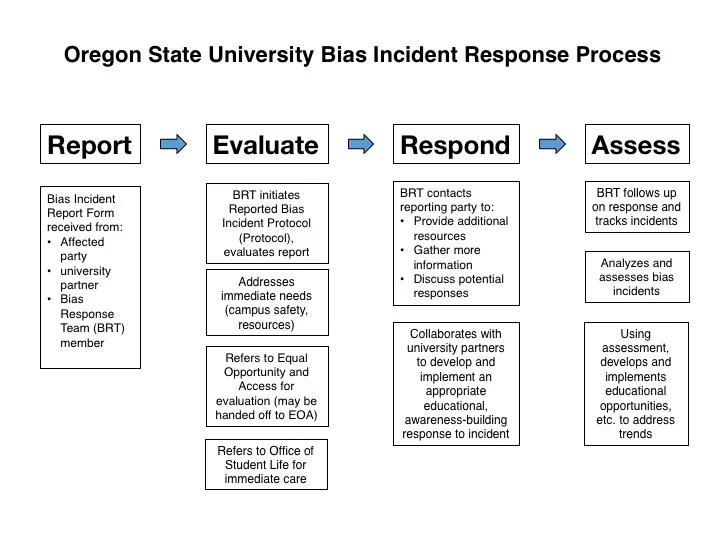What is a bias incident?
Oregon State University defines a bias incident as an act directed toward an individual or community based upon actual or perceived background or identity including: age, color, disability, gender identity or expression, marital status, national origin, race, religion, sex, sexual orientation, or veteran status.
Bias incidents can occur in a variety of settings, but have one important factor in common: they create a hostile working, learning or living environment and frequently have a negative psychological, emotional or physical effect on an individual or community.
Why is it important to respond to bias incidents?
Bias incidents create a hostile working, learning or living environment and frequently have a negative psychological, emotional, or physical effect on individuals and communities.
What can I do if I experience or witness a bias incident?
All Oregon State community members are encouraged to inform the Bias Response Team (BRT) of bias incidents by submitting a Bias Incident Report. Reports may be submitted anonymously, but the ability of the BRT to respond to anonymous reports is limited.
What does the Bias Response Team do when it receives information about a bias incident?
Oregon State has Reported Bias Incident Response Protocol to guide its response to bias incidents. When a report is submitted, the BRT carefully evaluates the report to identify needs and possible actions. The team seeks to prioritize a reporter's well-being, health, and safety and connects them to university resources that can offer more specialized support, while also facilitating appropriate educational interventions.
This process is represented in the chart below:

Should I submit a bias incident report, even if I don't know who is responsible?
Yes, reporting bias incidents allows the BRT to track trends in reported incidents, develop new educational resources tailored to the specific incidents and provide care to community members who may be negatively impacted. Reporting bias incidents, even when the responsible party is unknown, helps the university create an environment more responsive to countering bias when it occurs.
What if I am involved in the in the BRT process?
The bias response process is developmental and educational; it is not a formal investigation nor punitive process. Learn how you can show up fully in the bias response process and achieve positive outcomes for all involved. (Available soon.)